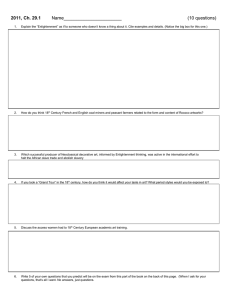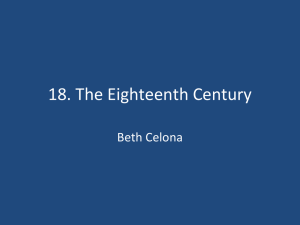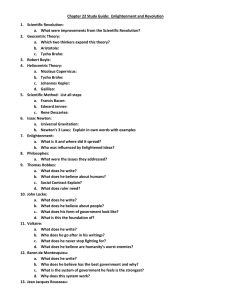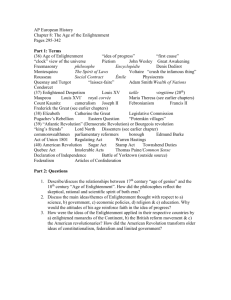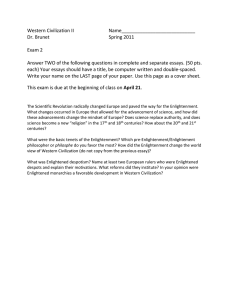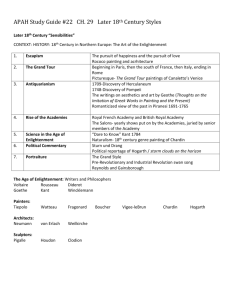I. Reading Questions
advertisement
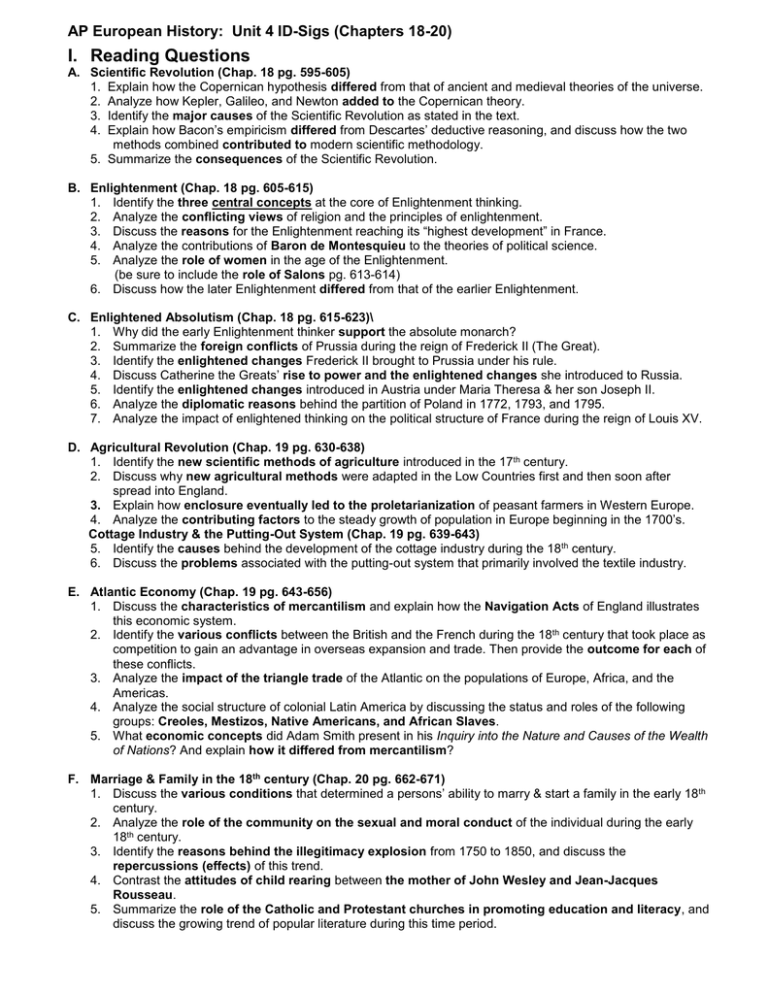
AP European History: Unit 4 ID-Sigs (Chapters 18-20) I. Reading Questions A. Scientific Revolution (Chap. 18 pg. 595-605) 1. Explain how the Copernican hypothesis differed from that of ancient and medieval theories of the universe. 2. Analyze how Kepler, Galileo, and Newton added to the Copernican theory. 3. Identify the major causes of the Scientific Revolution as stated in the text. 4. Explain how Bacon’s empiricism differed from Descartes’ deductive reasoning, and discuss how the two methods combined contributed to modern scientific methodology. 5. Summarize the consequences of the Scientific Revolution. B. Enlightenment (Chap. 18 pg. 605-615) 1. Identify the three central concepts at the core of Enlightenment thinking. 2. Analyze the conflicting views of religion and the principles of enlightenment. 3. Discuss the reasons for the Enlightenment reaching its “highest development” in France. 4. Analyze the contributions of Baron de Montesquieu to the theories of political science. 5. Analyze the role of women in the age of the Enlightenment. (be sure to include the role of Salons pg. 613-614) 6. Discuss how the later Enlightenment differed from that of the earlier Enlightenment. C. Enlightened Absolutism (Chap. 18 pg. 615-623)\ 1. Why did the early Enlightenment thinker support the absolute monarch? 2. Summarize the foreign conflicts of Prussia during the reign of Frederick II (The Great). 3. Identify the enlightened changes Frederick II brought to Prussia under his rule. 4. Discuss Catherine the Greats’ rise to power and the enlightened changes she introduced to Russia. 5. Identify the enlightened changes introduced in Austria under Maria Theresa & her son Joseph II. 6. Analyze the diplomatic reasons behind the partition of Poland in 1772, 1793, and 1795. 7. Analyze the impact of enlightened thinking on the political structure of France during the reign of Louis XV. D. Agricultural Revolution (Chap. 19 pg. 630-638) 1. Identify the new scientific methods of agriculture introduced in the 17th century. 2. Discuss why new agricultural methods were adapted in the Low Countries first and then soon after spread into England. 3. Explain how enclosure eventually led to the proletarianization of peasant farmers in Western Europe. 4. Analyze the contributing factors to the steady growth of population in Europe beginning in the 1700’s. Cottage Industry & the Putting-Out System (Chap. 19 pg. 639-643) 5. Identify the causes behind the development of the cottage industry during the 18th century. 6. Discuss the problems associated with the putting-out system that primarily involved the textile industry. E. Atlantic Economy (Chap. 19 pg. 643-656) 1. Discuss the characteristics of mercantilism and explain how the Navigation Acts of England illustrates this economic system. 2. Identify the various conflicts between the British and the French during the 18th century that took place as competition to gain an advantage in overseas expansion and trade. Then provide the outcome for each of these conflicts. 3. Analyze the impact of the triangle trade of the Atlantic on the populations of Europe, Africa, and the Americas. 4. Analyze the social structure of colonial Latin America by discussing the status and roles of the following groups: Creoles, Mestizos, Native Americans, and African Slaves. 5. What economic concepts did Adam Smith present in his Inquiry into the Nature and Causes of the Wealth of Nations? And explain how it differed from mercantilism? F. Marriage & Family in the 18th century (Chap. 20 pg. 662-671) 1. Discuss the various conditions that determined a persons’ ability to marry & start a family in the early 18th century. 2. Analyze the role of the community on the sexual and moral conduct of the individual during the early 18th century. 3. Identify the reasons behind the illegitimacy explosion from 1750 to 1850, and discuss the repercussions (effects) of this trend. 4. Contrast the attitudes of child rearing between the mother of John Wesley and Jean-Jacques Rousseau. 5. Summarize the role of the Catholic and Protestant churches in promoting education and literacy, and discuss the growing trend of popular literature during this time period. AP European History: Unit 4 ID-Sigs (Chapters 18-20) G. Food & Medicine (Chap. 20 pg. 672-680) 1. Compare and contrast the diets of the rich and poor in the 18th century and the impact on the health of each group. 2. Identify the various types of medical practitioners that existed in the 18th century and discuss the area of medicine each specialized in. Religion & Popular Culture (Chap. 20 pg. 680-685 3. Identify the three aspects of Pietism that help explain its powerful appeal during the 18th century, and discuss the impact of John Wesley on this revival. 4. Discuss the role of carnival in the communities of 18th century Europe, and explain how these traditions eventually served as a division between the elites and the commoners. II. ID-Sigs Chapter 18: Toward a New World-view (Reading: p. 595-623) Terms/Events Persons 1. 2. 3. 4. 5. Nicolaus Copernicus 6. Galileo Galilei 7. Francis Bacon 8. René Descartes 9. Voltaire 10. Jean Jacques Rousseau empiricism Enlightenment salon Enlightened Absolutism Chapter 19: The Expansion of Europe in the Eighteenth Century (Reading: p.629-656) Terms/Events 1. open-field system 2. enclosure movement 3. cottage industry 4. The War of Austrian Succession 5. The Seven Years War Persons 6. Olaudah Equiano 7. Adam Smith Chapter 20: The Changing Life of the People (Reading: p. 661-685) Terms/Events 1. killing nurses 2. foundling home 3. midwife 4. Protestant Revival 5. Carnival Persons 6. Edward Gibbon 7. Lady Mary Wortley Montagu 8. Edward Jenner
